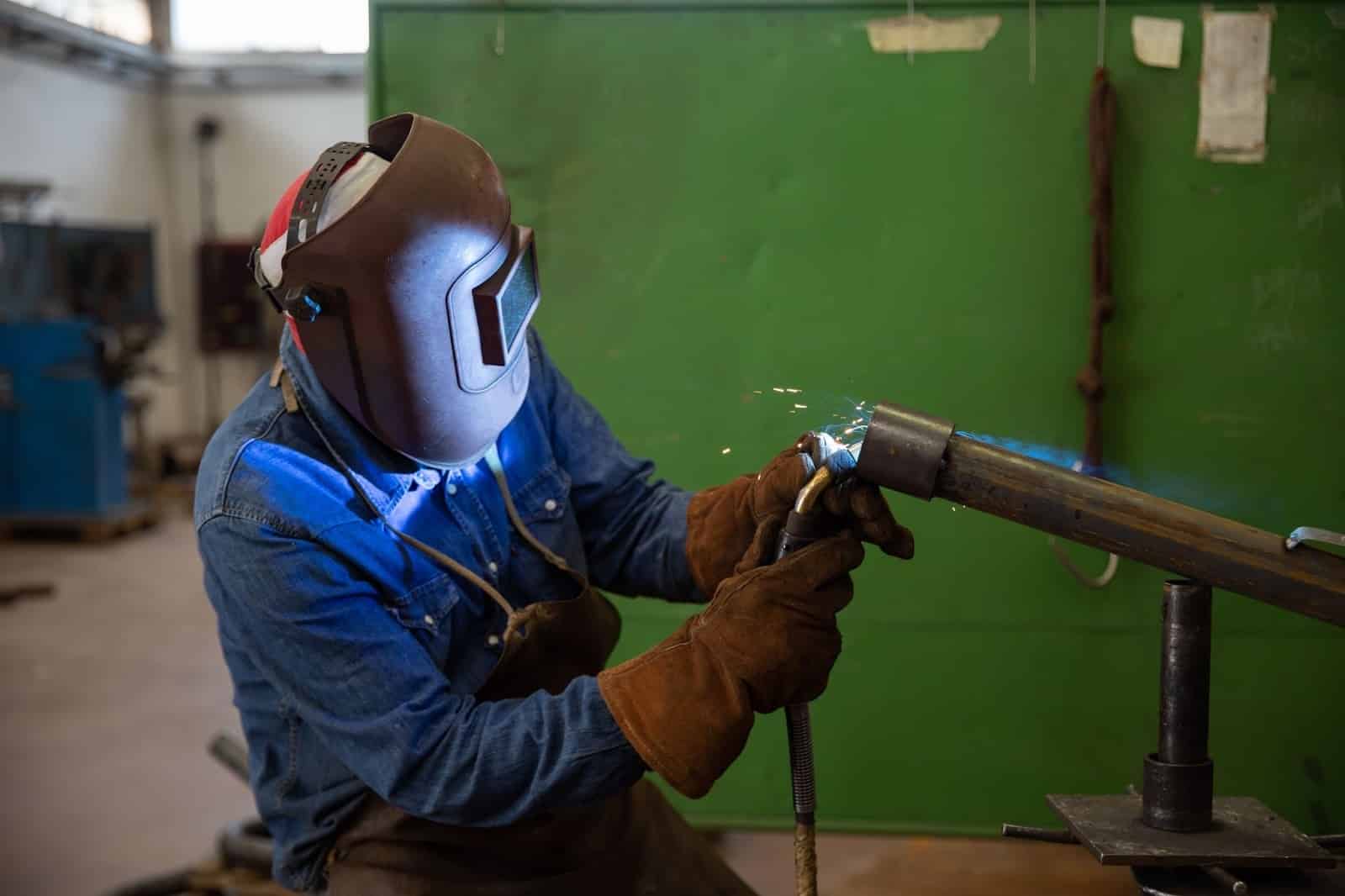Struggling to choose between stainless steel and carbon steel for your next project? Wondering why your stainless steel welds look completely different from your carbon steel joints?
Or maybe you’re facing challenges with heat input, distortion, or contamination that seem impossible to solve? You’re not alone, these material selection and welding technique questions plague both beginner and experienced welders daily.
Stainless steel welding requires precise control of heat and proper shielding to prevent oxidation, while carbon steel welding is relatively straightforward compared to stainless steel welding.
Understanding these fundamental differences in thermal conductivity, contamination sensitivity, and filler metal requirements will dramatically improve your welding results and help you choose the right material for each application.
Understanding the Fundamental Differences
Before diving into welding techniques, it’s crucial to understand what sets these materials apart at the molecular level. This knowledge directly impacts every welding decision you’ll make.
Stainless Steel Composition and Properties
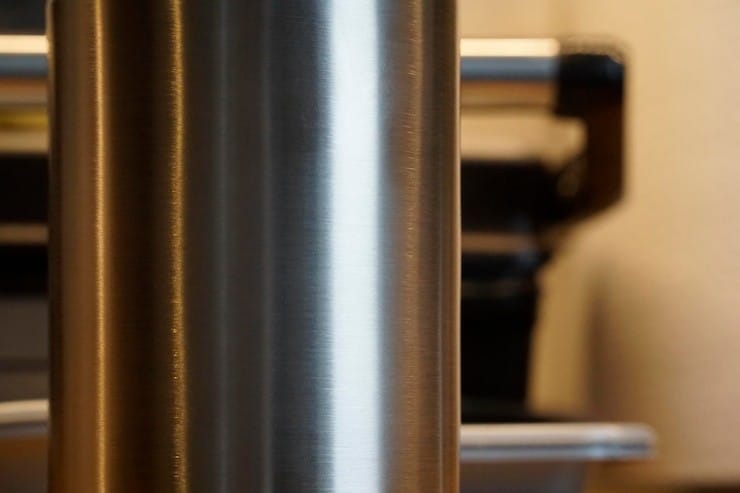
Stainless steel is an alloy of iron with a minimum of 10.5% chromium content. Common grades include 304, 316, and 430, each offering different properties suited for various applications. The chromium forms a passive oxide layer on its surface, providing exceptional resistance to corrosion and oxidation.
Key Welding Characteristics:
- Low thermal conductivity: Heat doesn’t dissipate quickly, leading to concentrated heat zones.
- High expansion coefficient: Significant movement during heating and cooling cycles.
- Contamination sensitivity: Chromium depletion can destroy corrosion resistance.
- Heat sensitivity: Prolonged high temperatures can cause carbide precipitation.
Carbon Steel Composition and Properties
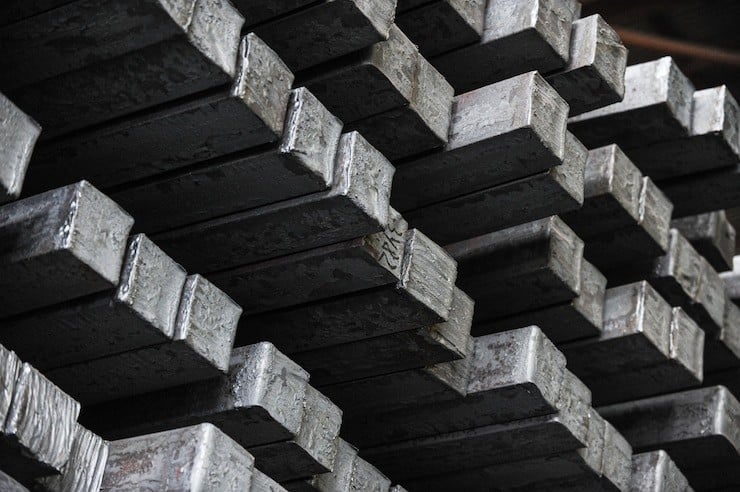
Carbon steel is primarily composed of iron and carbon, with trace amounts of other elements. Carbon steel is available in various grades, including low-carbon steel (also known as mild steel) and high-carbon steel, which differ in their carbon content and properties.
Key Welding Characteristics:
- Good thermal conductivity: Heat spreads evenly throughout the material.
- Predictable expansion: Consistent thermal behavior.
- Forgiving nature: Tolerates heat variations and minor technique inconsistencies.
- Magnetic properties: Useful for fixturing and positioning.
Heat Management is The Critical Difference
The most significant challenge when comparing stainless steel vs carbon steel welding lies in heat management. This fundamental difference affects every aspect of your welding technique.
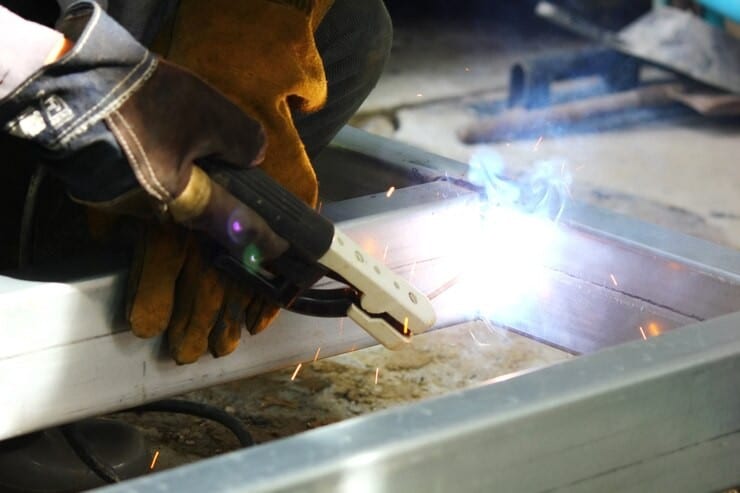
Stainless Steel Heat Challenges
Stainless steel has a low thermal conductivity, making it prone to overheating and distortion during welding. Because it doesn’t conduct heat away from the weld zone efficiently, heat builds up rapidly, creating several problems:
Overheating Issues
- Carbide precipitation: When stainless steel stays between 800-1400°F (426-760°C), chromium bonds with carbon, depleting the protective chromium and reducing corrosion resistance.
- Distortion: Concentrated heat causes significant warping.
- Burn-through: Thin sections are particularly vulnerable.
Heat Control Strategies
- Use lower amperage settings (10-15% less than carbon steel).
- Maintain fast travel speeds.
- Employ stringer beads instead of weaving.
- Utilize heat sinks (copper or brass backing bars).
- Allow cooling time between passes.
Carbon Steel Heat Management
Carbon steel’s good thermal conductivity makes heat management much more straightforward. Heat distributes evenly, reducing the risk of localized overheating and making the welding process more forgiving.
Advantages
- Consistent heat distribution prevents hot spots.
- Higher amperage tolerance.
- Less distortion risk.
- More forgiving to technique variations.
TIG Welding: Precision Techniques for Each Material
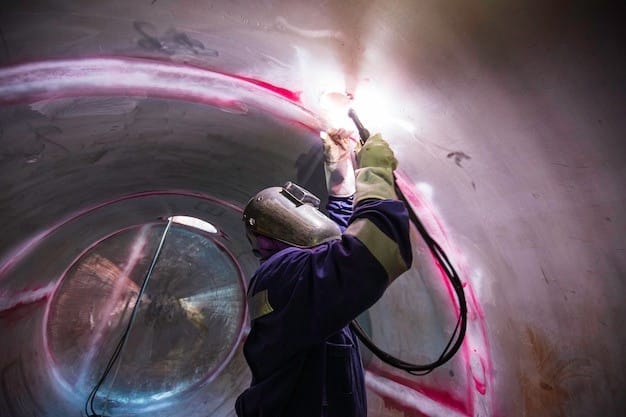
TIG welding showcases the clearest differences between stainless steel vs carbon steel welding techniques. The precision required varies dramatically between materials.
TIG Welding Stainless Steel
TIG equipment is preferred for thinner stainless steel materials due to its precision and ability to produce high-quality welds. However, it requires exceptional technique control.
Critical Requirements:
- Contamination prevention: Use only stainless steel tools (wire brushes, clamps, fixtures).
- Gas coverage: Ensure complete argon purging, especially for full-penetration welds.
- Heat control: it takes a little less amperage than carbon steel.
- Arc length: Use really short arc length due to poor heat conduction.
Professional Technique Tips
- Set machine for pre-purge and post-purge gas flow.
- Avoid weaving motions that increase heat input.
- Never weld over rainbow-colored heat tint (indicates contamination).
- Use backing gas for critical applications.
TIG Welding Carbon Steel
TIG welding carbon steel is often preferred on thinner pieces, where you want to avoid high heat that can cause brittleness and cracking. The process is more straightforward and forgiving.
Standard Approach
- Higher amperage tolerance than stainless steel.
- Less critical gas coverage requirements.
- More forgiving arc length control.
- Standard heat input calculations apply.
Gas Recommendations
- Argon: Excellent for oxidation protection and arc stability.
- Helium: Provides hotter arc and more fluid weld pool, but requires lower amperage.
MIG Welding: Production Efficiency Differences
MIG welding reveals distinct parameter differences when comparing stainless steel vs carbon steel welding applications.

MIG Welding Stainless Steel
Professional MIG welder is suitable for thicker stainless steel sections and provides higher deposition rates, making it more efficient for larger projects. However, specific parameters must be adjusted.
Parameter Adjustments
- Reduced heat input: 10-15% less amperage than carbon steel.
- Modified gas mixtures: Higher argon content (90% Ar/10% CO2) for better arc stability.
- Specialized wires: Use 308L for 304 stainless, 316L for 316 stainless.
- Contamination control: Dedicated stainless-only equipment.
Transfer Mode Considerations
- Short circuit: Best for thin materials and out-of-position welding.
- Spray transfer: Suitable for thicker sections in flat position.
- Pulse spray: Optimal for maintaining low heat input while achieving good penetration.
MIG Welding Carbon Steel
Carbon steel exhibits good weldability, allowing for ease of joining and fabrication using common welding processes such as stick welding, MIG welding, and TIG welding.
Standard Settings
- Gas mixture: 75% Argon/25% CO2 (C25) for quality, or 100% CO2 for penetration.
- Filler wire: ER70S-6 for most applications.
- Higher tolerance: More forgiving parameter ranges.
- All-position capability: Excellent results in any welding position.
Recommended Parameters by Thickness
- 1/8″ material: ~125 amps, 22-24V.
- 1/4″ material: ~180-200 amps, 24-26V.
- 3/8″ material: ~225-250 amps, 26-28V.
Filler Metal Selection
Choosing the correct filler metal represents one of the most critical decisions in stainless steel vs carbon steel welding.
Stainless Steel Filler Requirements
The selection of filler metal for stainless steel depends on the base metal grade and the application requirements.
Common Filler Metals
- ER308L: Universal choice for 304 stainless steel.
- ER316L: Required for 316 stainless steel applications.
- ER309L: Used for welding stainless to carbon steel (dissimilar metals).
- ER310: High-temperature applications.
Critical Considerations
- Match or slightly exceed base metal corrosion resistance.
- Consider service temperature requirements.
- Account for dilution effects with base metal.
Carbon Steel Filler Selection
Carbon steel filler metal selection follows straightforward matching principles.
Standard Options:
- ER70S-6: Most common choice for mild steel.
- E7018: Low-hydrogen stick electrode for critical applications.
- ER80S-D2: For higher-strength applications.
Selection Criteria
- Match tensile strength requirements.
- Consider hydrogen content for crack-sensitive applications.
- Account for post-weld heat treatment requirements.
Cost and Material Selection Factors
The economic impact of stainless steel vs carbon steel welding extends beyond material costs.
Stainless Steel Economic Factors
Higher Initial Costs:
- Material cost: 3-5x more expensive than carbon steel.
- Specialized consumables required.
- Dedicated equipment for contamination prevention.
- Skilled labor requirements.
Long-term Value:
- Extended service life in corrosive environments.
- Reduced maintenance costs.
- Lower total cost of ownership in appropriate applications.
Carbon Steel Economic Benefits
Lower Initial Investment
- Readily available and economical material.
- Standard welding consumables.
- Broader welder skill base.
- Flexible equipment requirements.
Application Suitability:
- Excellent for structural applications.
- Cost-effective for high-volume production.
- Suitable when corrosion resistance isn’t critical.
Application-Specific Recommendations
Choosing between stainless steel vs carbon steel welding depends on specific application requirements.
When to Choose Stainless Steel
| Application | Requirement |
| Food processing equipment | Hygiene and corrosion resistance required. |
| Chemical processing | Corrosive environment exposure. |
| Marine applications | Salt water exposure. |
| Architectural features | Aesthetic and durability requirements. |
| Medical devices | Biocompatibility and sterilization needs. |
When to Choose Carbon Steel
| Application | Requirement |
| Structural components | High strength-to-weight ratio needed. |
| General fabrication | Cost-effectiveness priority. |
| Machinery frames | Magnetic properties beneficial. |
| Temporary structures | Short service life applications. |
| High-volume production | Economic considerations paramount. |
Advanced Welding Techniques
Professional welders employ specialized techniques for optimal results in stainless steel vs carbon steel welding.
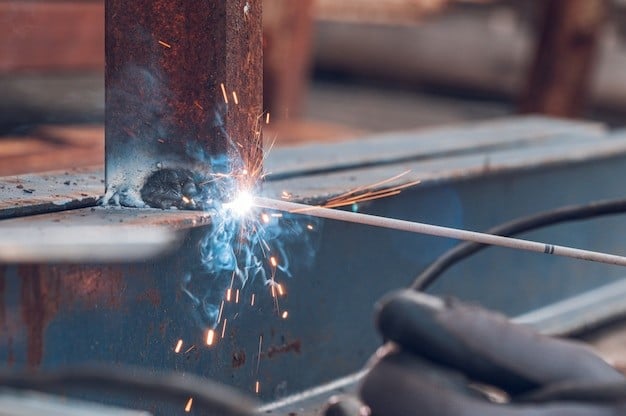
Stainless Steel Advanced Methods
Pulsed Welding:
- Reduces overall heat input.
- Improves penetration control.
- Minimizes distortion risk.
Back-purging:
- Essential for full-penetration welds.
- Prevents oxidation on weld root.
- Maintains corrosion resistance through entire thickness.
Heat Sinking: Use heat sinks to prevent burn-through, warping, and other issues. A heat sink is simply a block of brass or copper clamped to the workpiece behind the seam, along the length of the weld.
Carbon Steel Production Techniques
Multi-pass Strategies
- Higher deposition rates possible.
- Less critical interpass temperature control.
- Robust joint designs achievable.
All-position Welding
- Excellent out-of-position characteristics.
- Flexible electrode selection.
- Forgiving parameter ranges.
Closing Thoughts
The choice between stainless steel vs carbon steel welding ultimately depends on balancing performance requirements, environmental conditions, and economic factors.
Stainless steel welding requires precise control of heat and proper shielding to prevent oxidation, demanding higher skill levels and specialized equipment. Carbon steel welding is relatively straightforward, offering excellent weldability and cost-effectiveness for structural applications.
Understanding these fundamental welding differences ensures successful project outcomes. Master the specific techniques for each material, and you’ll be equipped to handle any welding challenge that comes your way.
The best welding results are achieved by matching your material choice, welding process, and technique to your specific application requirements. When in doubt, consult welding procedure specifications and consider test welds to verify your approach before committing to full production.
When you need equipment that handles both the precision demands of stainless steel and the robust requirements of carbon steel welding, YesWelder delivers. Our welders feature the advanced controls and consistent performance that professional fabricators depend on.


